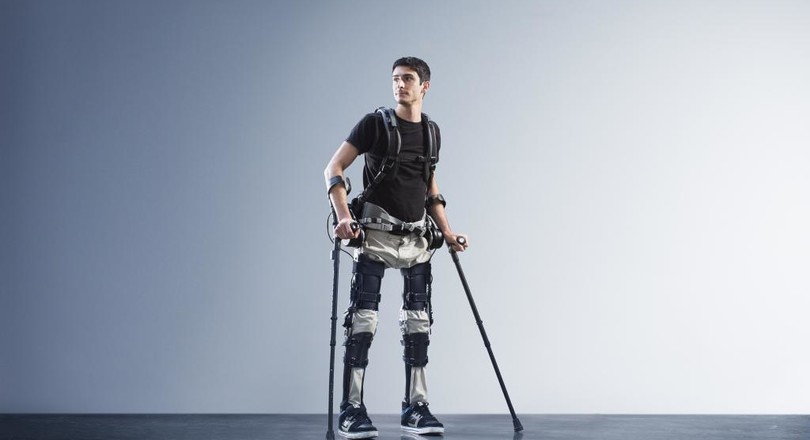RoboCop. Terminator. Yeah, they’ve heard all that before.
And in fact, if you saw someone stand up, wearing one of these, heading your way, your first instinct might be to look for the nearest exit…

…but in fact, what you’d be seeing, is one of the closest things to a miracle on this earth.*
Because Paul Meyer, Dan Rose, Maria Rea or any of the other men and women who strap themselves into one of those exoskeletons, get up and walk across a room – are men and women who were told they’d never walk again.
Army Sergeant Dan Rose was on a mine-sweeping operation in Afghanistan, when a mine exploded. When he came to, he was upside down and his legs didn’t move.
When her car went off the road in rural Georgia, teacher Maria Rea was thrown seventy-five feet away, into a field, her hip and pelvis shattered, unable to walk.
Police Officer Paul Meyer was on a training exercise, when a 110-foot tree fell over on him, paralyzing him from the waist down.
And yet, now, they walk.
Once upon a time though, that would not have been possible. The severity of their injuries would probably have meant, that the only way of getting around would have been in a wheelchair. What’s changed that, is the exoskeleton – which is, in fact, a little like a skeleton you wear on the outside.
Technically, it’s a wearable “device”. It can be strapped onto, over legs, hips, torso, arms, all of the above. It isn’t like armor, because it doesn’t just sit there. But it isn’t robotic either, because it doesn’t do all the work for you. These exoskeletons have sensors and power – but they also require your “sensors” and your “power”.
There’s plenty that goes into the making of an exoskeleton. One important part are the materials made possible by petrochemicals. Petrochemicals like ethylene and butadiene.
Now if you don’t spend 9 to 5 in a lab, those names might set your head spinning a bit. So here’s how that works. From crude oil or natural gas, we can make various chemicals (“petrochemicals” like ethylene and butadiene) – from those chemicals, we can make various materials (like the ABS and polycarbonate in exoskeletons) – and from those plastics we can make, almost anything, it turns out. Like exoskeletons.
Christy Smitheran, a physical therapist who teaches people how to use the exoskeleton device, has more than one story about someone who got up and walked across a room for the first time after their accident. After they’d been told they’d never walk again. Maybe after they believed they’d never walk again. And they just cry.
That isn’t to say it’s easy. Fifteen minutes in the exoskeleton and, as Smitheran says, you’re “sweating buckets.” It’s a workout. A hard workout. But for someone who’s been told they’ll never walk again, that workout is an unimaginable gift.
But these exoskeletons are not workout machines. You put one on, so that you can walk across the room. So you can walk up, and down the stairs in your house. So you can walk outside. So you can walk in the park, on the grass. So you can walk with your kids, your sweetheart, your friends.
So that Paul Meyer could stand, raise his right hand and take the oath to receive his promotion to police sergeant, Portland Bureau of Police.
So that Dan Rose could stand for the playing of the National Anthem at the Indianapolis 500.
So that Rylie, Maria Rea’s seven-year-old daughter, could see for the first time in her young life, her mom walking.
So. Even though the word “petrochemical” sounds pretty down to earth — and certainly not the stuff dreams are made of — there are dreams in those ethylenes and butadienes. Like this one.
A wounded vet comes home from war, paralyzed, in a wheelchair – and his young niece imagines someday, taking a walk with her uncle. Now, she can.
*That particular miracle, is an exoskeleton made by ReWalk.
Original article can be found at Imagine That’s website.











